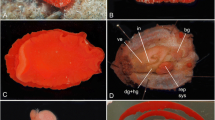Abstract
Combined faunistic and genetic studies in the marine Ekamako Cave at the southern coast of Nuku Hiva, Marquesas, in the central Pacific, yielded Heteromysis (Olivemysis) ekamako as a new species. This taxon differs from its congeners by a specific combination of morphological characters: flagellate, modified spines dorsally on each of the three segments of the antennular peduncle, a large smooth spine at the tip of only the second male pleopod, series of small flagellate spines along the oblique terminal margin of only the third and fourth male pleopods, and by 2–3 simple spines medially near the statocyst on the endopods of uropods. Although abundant at the entrance of Ekamako Cave, it has not been observed in nine additional submersed marine caves investigated at the Marquesas.



Similar content being viewed by others
References
Ariani AP, Wittmann KJ, Franco E (1993) A comparative study of static bodies in mysid crustaceans: evolutionary implications of crystallographic characteristics. Biol Bull 185:393–404
Băcescu M (1968) Heteromysini nouveaux des eaux cubaines: trois espèces nouvelles de Heteromysis et Heteromysoides spongicola n.g. n.sp. Rev Roum Biol – Zool 13:221–237
Băcescu M (1970) New spongicolous Heteromysis of the Caribbean Sea (H. gomezi n. sp. and H. mariani n. sp.). Rev Roum Biol – Zool 15:11–16
Băcescu M, Iliffe TM (1986) Contribution to the knowledge of Mysidacea from western Pacific: Aberomysis muranoi n. gen., n. sp. and Palaumysis simonae n. gen., n. sp. from marine caves on Palau, Micronesia. Trav Mus Hist Nat “Grigore Antipa” 28:25–35
Brattegard T (1970) Mysidacea from shallow water in the Caribbean Sea. Sarsia 43:111–154
Chevaldonné P, Sket B, Marschal C, Lejeusne C, Calado R (2008) Improvements to the “Sket bottle”: a simple manual device for sampling small crustaceans from marine caves and other cryptic habitats. J Crustac Biol 28:185–188
Chevaldonné P, Rastorgueff PA, Arslan D, Lejeusne C (2015) Molecular and distribution data on the poorly known, elusive, cave mysid Harmelinella mariannae (Crustacea: Mysida). Mar Ecol 36:305–317
Murano M (1995) New and already known species of the genus Anisomysis (Mysidacea) from Hawaii and the Society Islands. J Crustac Biol 15:355–364
Pérez T, Albenga L, Starmer J, Chevaldonné P (2016) La biodiversité des grottes sous-marines des Marquises: un patrimoine naturel caché et méconnu. In: Galzin R, Duron SD, Meyer JY (eds) Biodiversité terrestre et marine des îles Marquises, Polynésie Française. Société Française d’Ichtyologie, Paris, 24 pp (in press)
Poupin J, Corbari L, Pérez T, Chevaldonné P (2012) Deep-water decapod crustaceans studied with a remotely operated vehicle (ROV) in the Marquesas Islands, French Polynesia (Crustacea: Decapoda). Zootaxa 3550:43–60
Tattersall WM, Tattersall OS (1951) The British Mysidacea. Ray Society, London, 460 pp
Wittmann KJ (2000) Heteromysis arianii sp. n., a new benthic mysid (Crustacea, Mysidacea) from coralloid habitats in the Gulf of Naples (Mediterranean Sea). Ann Naturhist Mus Wien B 102:279–290
Wittmann KJ (2001) Centennial changes in the near-shore mysid fauna of the Gulf of Naples (Mediterranean Sea), with description of Heteromysis riedli sp. n. (Crustacea, Mysidacea). Mar Ecol 22:85–109
Wittmann KJ (2004) Retromysis nura new genus and species (Mysidacea, Mysidae, Heteromysini) from a superficial marine cave in Minorca (Balearic Islands, Mediterranean Sea). Crustaceana 77:769–783
Wittmann KJ (2008) Two new species of Heteromysini (Mysida, Mysidae) from the Island of Madeira (N.E. Atlantic), with notes on sea anemone and hermit crab commensalisms in the genus Heteromysis S. I. Smith, 1873. Crustaceana 81:351–374
Wittmann KJ, Ariani AP, Lagardère JP (2014) Orders Lophogastrida Boas, 1883, Stygiomysida Tchindonova, 1981, and Mysida Boas, 1883 (also known collectively as Mysidacea). In: von Vaupel Klein JC, Charmantier-Daures M, Schram FR (eds) Treatise on zoology—anatomy, taxonomy, biology. The Crustacea. Revised and updated, as well as extended from the Traité de Zoologie, vol. 4 part B (54). Brill, Leiden, pp 189–396, colour plates pp 404–406
Acknowledgments
First of all, we wish to thank Thierry Pérez for leading Leg 3 of the “Pakaihi I Te Moana” expedition and for the Ekamako Cave dives with one of us (PC). We are also indebted to Xavier “Pipapo” Curvat for showing us the cave, to Laurent Albenga and John Starmer for their hard work underwater, and to the captain and crew of R/V Braveheart. The French Agence des Aires Marines Protégées (AAMP) was the main sponsor and coordinator of this expedition. The Marquesan people are warmly thanked for their spirit and hospitality.
Author information
Authors and Affiliations
Corresponding author
Ethics declarations
Conflict of interest
The authors declare that they have no conflict of interest.
Additional information
Communicated by A. Brandt
This article is registered in ZooBank under urn:lsid:zoobank.org:pub:6204EFB9-19C2-43B8-8E0E-0D180BC13567
Rights and permissions
About this article
Cite this article
Wittmann, K.J., Chevaldonné, P. Description of Heteromysis (Olivemysis) ekamako sp. nov. (Mysida, Mysidae, Heteromysinae) from a marine cave at Nuku Hiva Island (Marquesas, French Polynesia, Pacific Ocean). Mar Biodiv 47, 879–886 (2017). https://doi.org/10.1007/s12526-016-0522-1
Received:
Revised:
Accepted:
Published:
Issue Date:
DOI: https://doi.org/10.1007/s12526-016-0522-1




